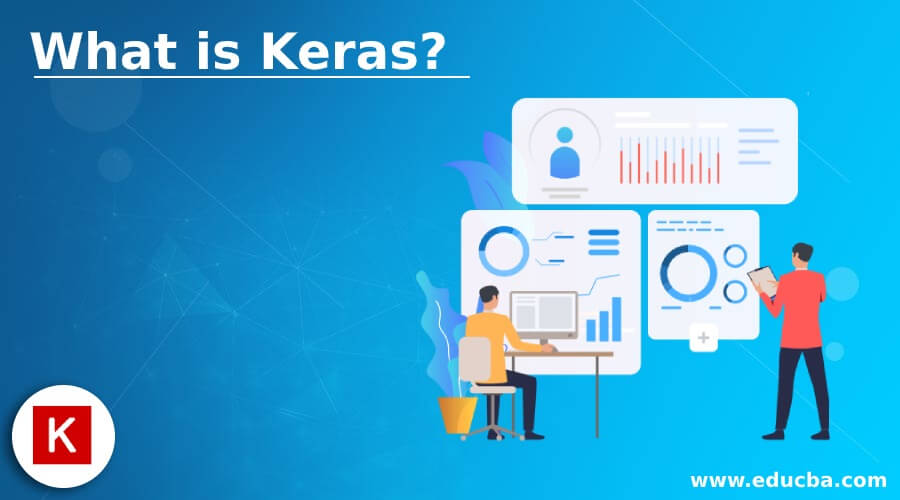Updated March 13, 2023
What is Keras?
Keras is a high-level open-source library for the neural network, built with Python, which can be run on Theano, CNTK, or TensorFlow. It has been created by Franco is Chollet, one of Google’s engineers. It is extensible, user-friendly, and scalable for faster neural network experimentation. It does support CNN’s individually as well as their combination. They do not only support CNs. It is unable to handle low-level calculations, so the Backend library is used to solve it. This backend library is used for an API wrapper, which can run on TensorFlow, Theano, or CNTK. The backend library is a low-level API. At first, it had more than 4,800 contributors at the beginning and now has 250,000 developers. It has been growing so fast, it has a 2x raise. Big companies such as Microsoft, NVIDIA, Google, and Amazon have contributed actively to Keras’ growth. The industry integrates well and is used for the growth of famous companies such as Google, Netflix, Uber, Expedia, etc.
Principles of Keras
It has been designed to work with Python, quickly, and easily. The API was ‘made for people, not computers’ and ‘follows best practices for cognitive pressure reduction.’ All standalone modules that can be combined to construct new models are neural layers, cost functions, optimization schemes, activation features, and regularization schemes. As new groups and functions, new modules can be introduced quickly. Models, not separate model configuration files, are specified in Python code.
The user experience of Keras:
- It is Not designed for machines: In most common applications, it offers direct feedback on any mistake that limits the no. of user actions.
- Highly Flexible: The incorporation of deep learning languages such as Theano, and, TensorFlow ensures that anything written in the basic language is able to implement in Keras, giving it high versatility for all its developers.
- API designed for humans: Keras implements best practices to decrease cognitive load, maintain the accuracy of the models and the correct APIs.
Keras Backend
Keras is an excellent library and provides high-level building blocks in the development of a deep learning model. Keras does not manage all low-level calculations such as tensioner products, convolutions, etc. but rather relies on the specialized library of tensor manipulation that is optimized better to function as the backend engine. It was beautifully handled by Keras that it provides the link of many back-end engines to Keras instead of integrating a single library of tensors and operations correlated to that specific library.
Keras consists of the following three bottom-up engines:
- CNTK: Microsoft Cognitive Toolkit is an open-source platform for deep learning. This consists of all the basic components required to form a neural network. The models are C++ or Python educated, but they use C # or Java for the prediction of the test.
- TensorFlow: TensorFlow is a product of Google that is one of the most well-known profound learning tools in machine learning and in the networking research field. It was released under the Apache License 2.0 on 9 November 2015. It is designed so that multiple CPUs and GPUs, as well as smartphone operating systems, can easily be run. This is made of different wrappers in different languages like Java, Python, C++,
- Theano: Theano was created by the MILA group in the University of Montreal, Canada. Theano is an open-source python library commonly used to perform multi-dimensional mathematical operations, including NumPy, and scipy. It uses GPUs for speedier calculation and calculates the gradients efficiently by automatically constructing symbolic graphs. It has proven very useful for unstable languages, as it numerically analyses them and then calculates them using highly stable algorithms.
Features of Keras
Some of the features are given below:
- It is a multi-backend and supports a multi-platform that allows the coding of all encoders.
- It provides the freedom to build any architecture, which is later used as the project’s API.
- In reality, Keras is unique because of the easy development of models.
- Keras’ research group fits extremely well with the development community.
- This is a multi-backend that supports a multi-platform that supports all encoders to code together.
Advantages
Some of the advantages are given below:
- The faster implementation of network models is very easy to implement and understand.
- It supports multi backend that means users can use all of them with a backend of Keras according to user requirements, including CNTK, TensorFlow, and Theano.
- It supports parallel processing, meaning that Keras can be taught on several GPUs in order to speed up the training time and process large quantities of data.
Recommended Articles
This is a guide to What is Keras?. Here we also discuss the introduction and principles of Keras along with features and advantages. You may also have a look at the following articles to learn more –



